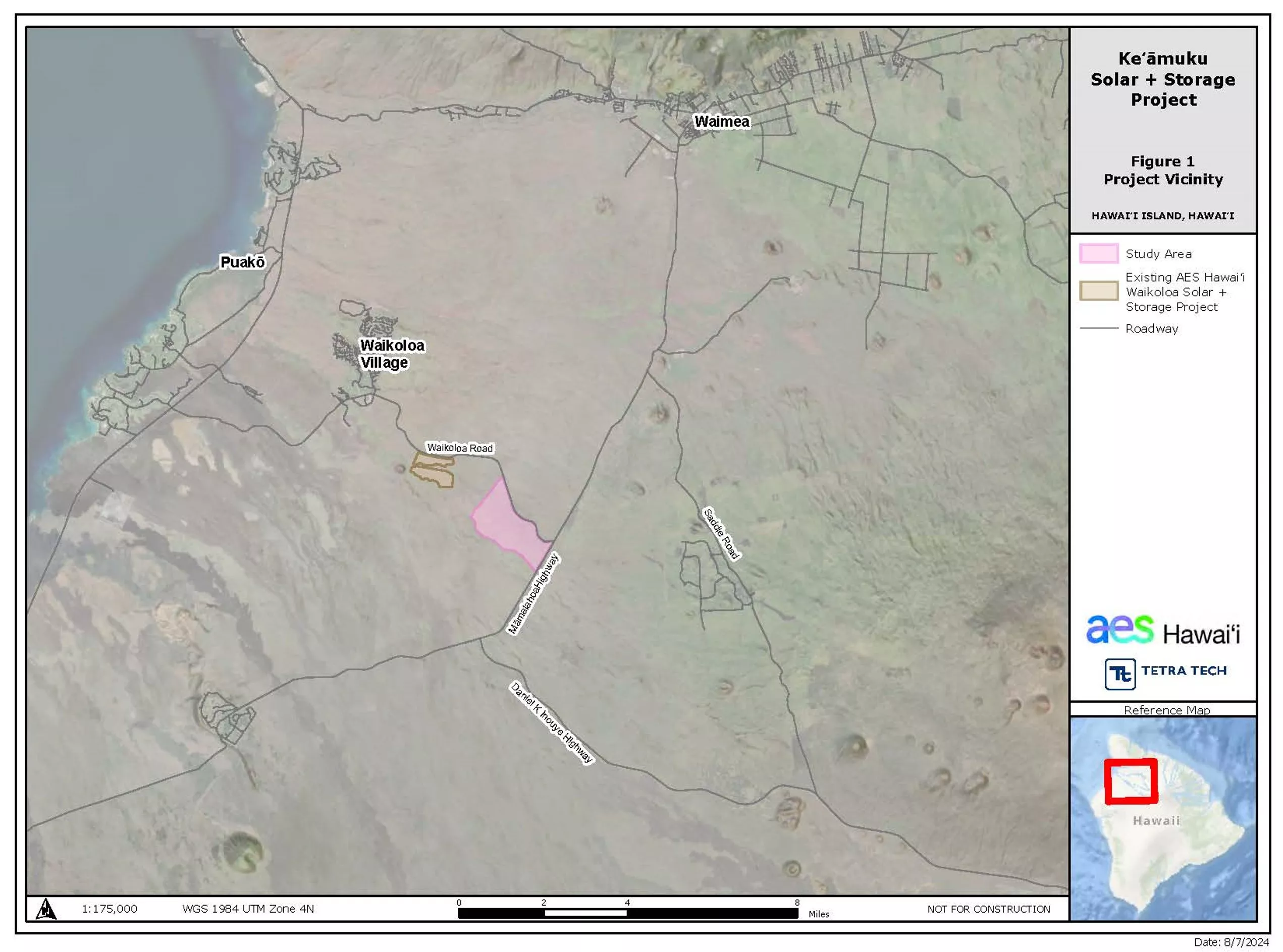Hawaiʻi’s 100% clean energy future
As Hawaiʻi accelerates its transition to a 100% renewable future by 2045, AES Hawaiʻi is partnering with utilities, communities, landowners and customers to deliver greener, smarter energy solutions and help ensure a responsible and equitable transformation to clean energy. Since the 1980s, our people have worked passionately to meet Hawaiʻi's growing energy needs. Working together, we are co-creating solutions that support Hawaiʻi’s renewable generation goals, stabilize rates and increase grid reliability.
Contact us
We appreciate your interest and participation in Hawaiʻi’s renewable energy future. We look forward to hearing your ideas and comments.
Community Outreach Representative:
Carrice Gardner
Email: keamukusolar@aes.com
Project Hotline: +1 (808) 800-3942
Project summary
The Keʻāmuku Solar + Storage project is a proposed 86 MW solar photo-voltaic array and 344 MWh Battery Energy Storage System (BESS) that will be developed and operated by AES Hawai‘i.
The Project will be located on land owned by AES Hawai‘i adjacent to Waikoloa Road and Māmalahoa Highway on Hawai‘i Island.
- Specifications: 86 MW solar photovoltaic array plus 344 MWh containerized lithium-ion Battery Energy Storage System (BESS).
-
Power Purchase Agreement: The project will deliver power to serve Hawaiʻi Island residents under a 25-year Power Purchase Agreement with Hawaiian Electric at a low, fixed cost over that time span.
-
Decommissioning: AES Hawaiʻi will restore the land to its existing condition (or comparable) at the end of the Project’s life.
-
Project study area: To responsibly site the Project, reduce potential grading and fill, as well as avoid sensitive features, AES Hawaiʻi studied approximately 1,090 acres of land.
-
Preliminary project area: The Project is currently contemplated to be sited within a preliminary project area of approximately 757 acres.
-
Preliminary project footprint: Solar panels, batteries, substation, and other project components are anticipated to cover an area of approximately 165 acres.
Updated Project area
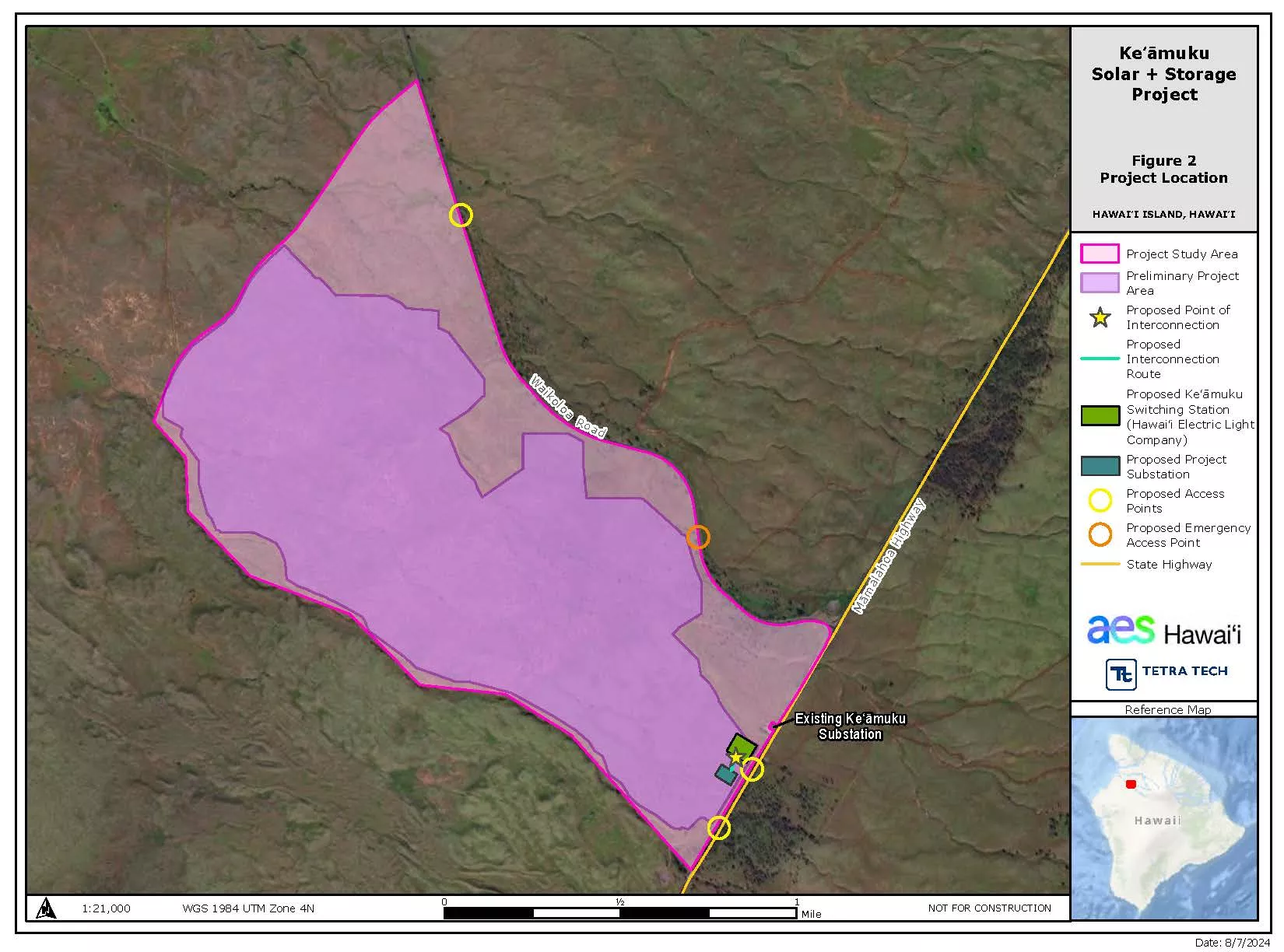
Updated Project layout
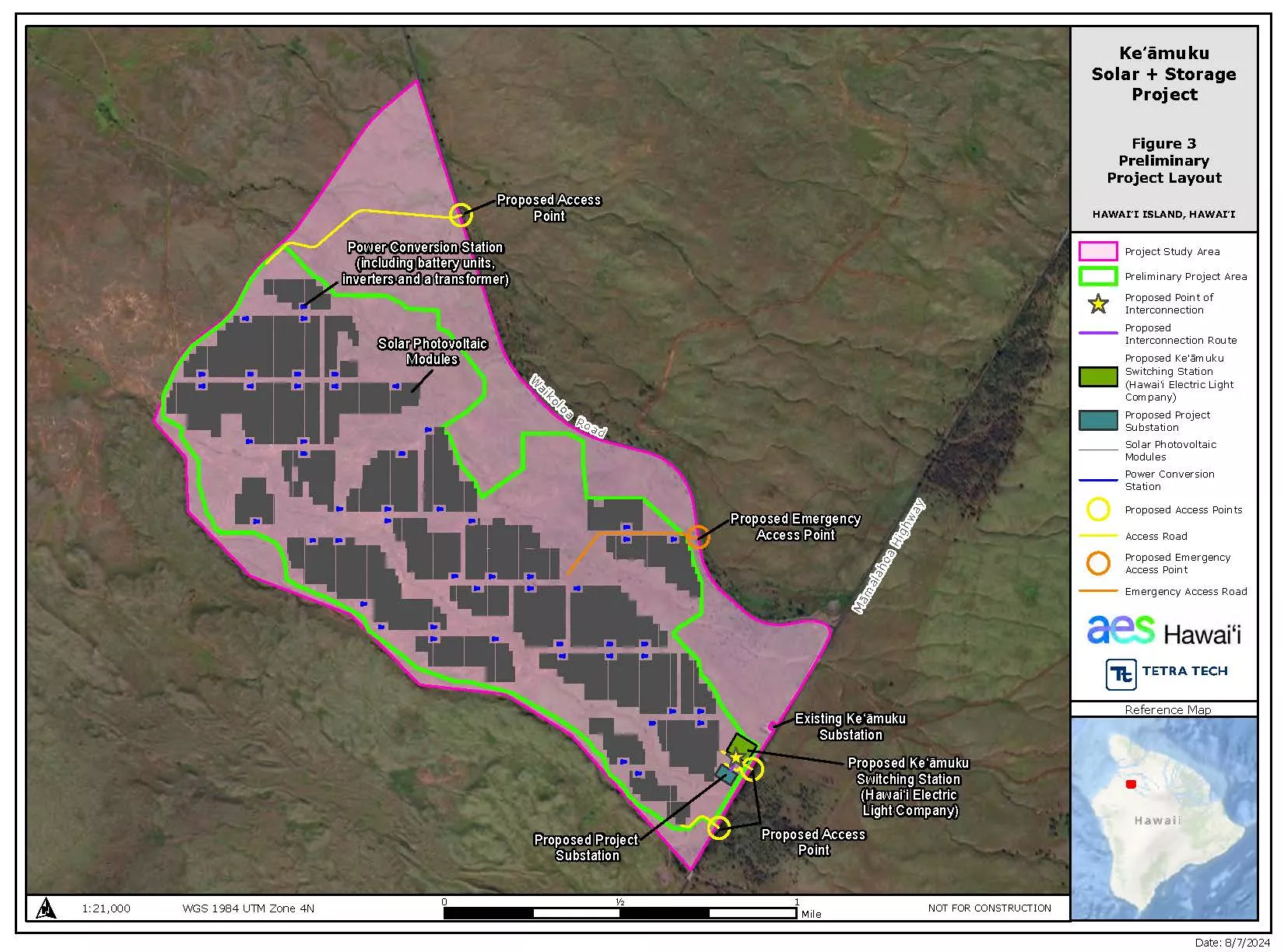
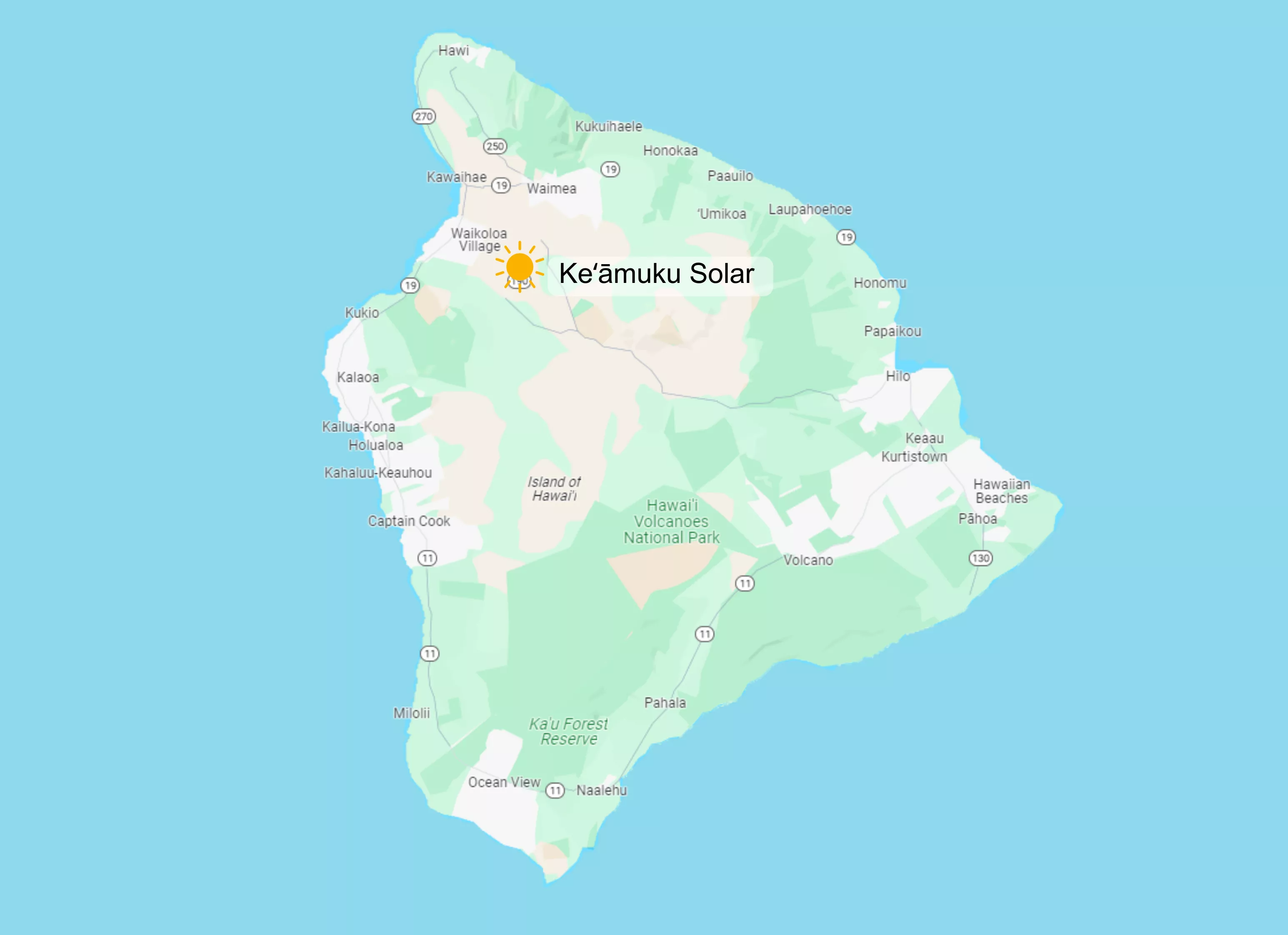
Interconnection route
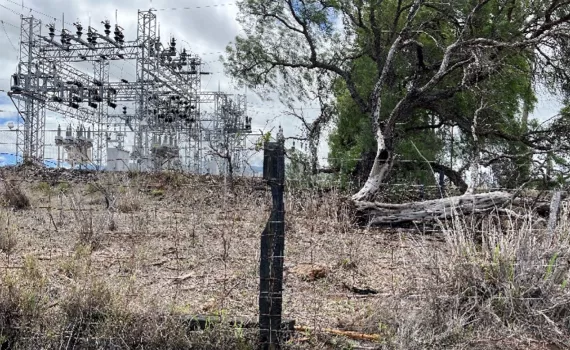
The Project is proposing to interconnect to the Hawaiʻi Electric Light Company grid at the newly proposed Keʻāmuku substation. The substation will be rebuilt on land approximately 350'-500' away from the existing Hawaiʻi Electric Light Company Keʻāmuku substation.
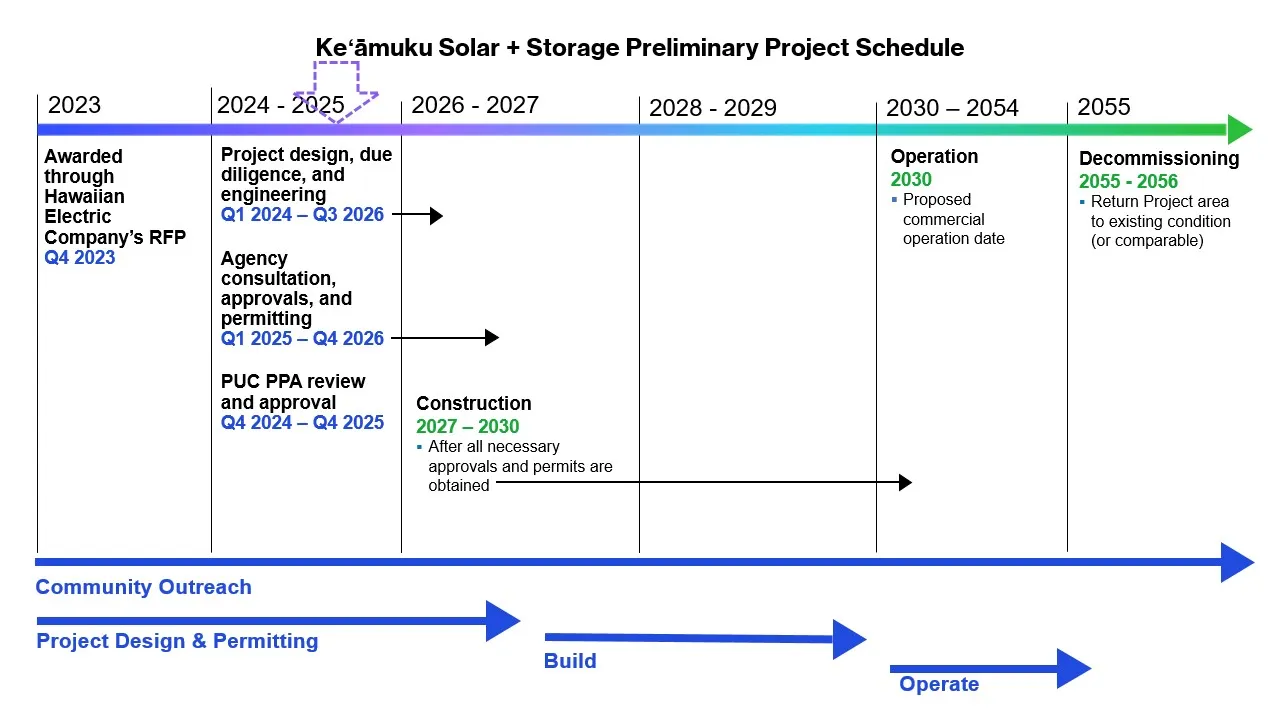
AES Hawai'i is deeply committed to being an active, invested member of the communities we serve.
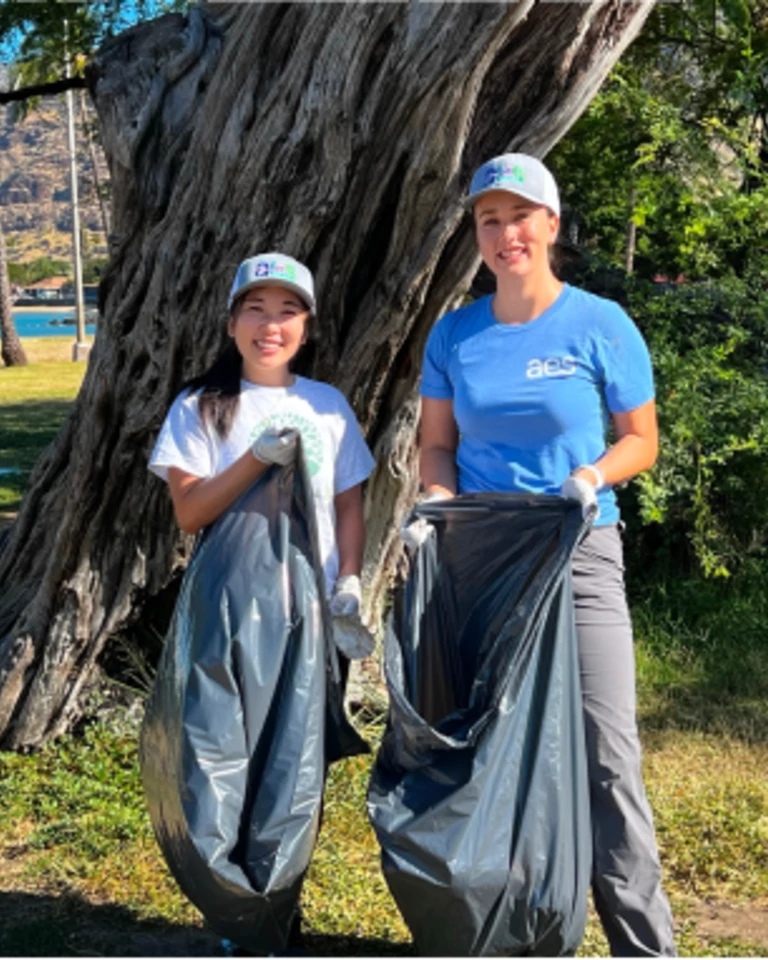
AES Hawai'i has a track record of successfully and sensitively engaging with the community and stakeholders near the proposed project. AES Hawai'i recently completed construction and is now operating the Waikoloa Solar + Storage project adjacent to the proposed project.
Continuing to identify communities and other interested stakeholders affected by the Project is an essential part of project planning. Upon award, the AES Hawai'i team began engagement with area organizations and leaders to provide timely and relevant project information and collect feedback to refine and finalize the Project’s design with community input.
We intend to make every effort to keep the following list up to date throughout the Project’s lifecycle. To date, AES Hawai'i has identified the following organizations, landowners, community leaders, and key-decision makers that have or will be engaged in the Project outreach process:
- Kilauea Trust
- TDA Investment Group
- Waikōloa Dry Forest Initiative
- Waimea Community Association
- Waikōloa Village Association
- Waikoloa Community Leadership Council
- Area Councilmember Cindy Evans
- Area Senator Tim Richards
- Area House Representatives David Tarnas and Nicole Lowen
AES Hawaiʻi's standard practice is to invite stakeholders to help identify others in the community who should be contacted, enabling the Project Team to continually expand its outreach. AES Hawaiʻi also welcomes input on stakeholders to include in outreach efforts through the Project website and hotline.
-
Local community support or opposition
-
AES Hawai'i conducted early stage outreach by commissioning a public opinion survey to understand community sentiment regarding the proposed Project.
The public opinion poll provides initial documentation of the community’s support for the Project. Of the West Hawai‘i residents who responded to our survey, the majority (71%) said they would support a solar and battery storage project capable of powering the equivalent of between 26,000 and 39,000 homes sited on approximately 600-900 acres in South Kohala. The majority of residents who supported the Project cited that it would be good for the environment or climate and would reduce the cost of electricity. Similarly, more than half support the Project because it would help reduce fossil fuel use. Other key reasons for support of the Project include the understanding that it would create new jobs and be good for the community and the economy. These results will shape our strategy for communicating the Project’s overall benefits.
During our ongoing community engagement process, AES Hawai'i will directly engage with stakeholders and seek feedback regarding the Project. This process will identify project support and opposition, along with community-identified concerns about project design, location, and potential impacts.
Image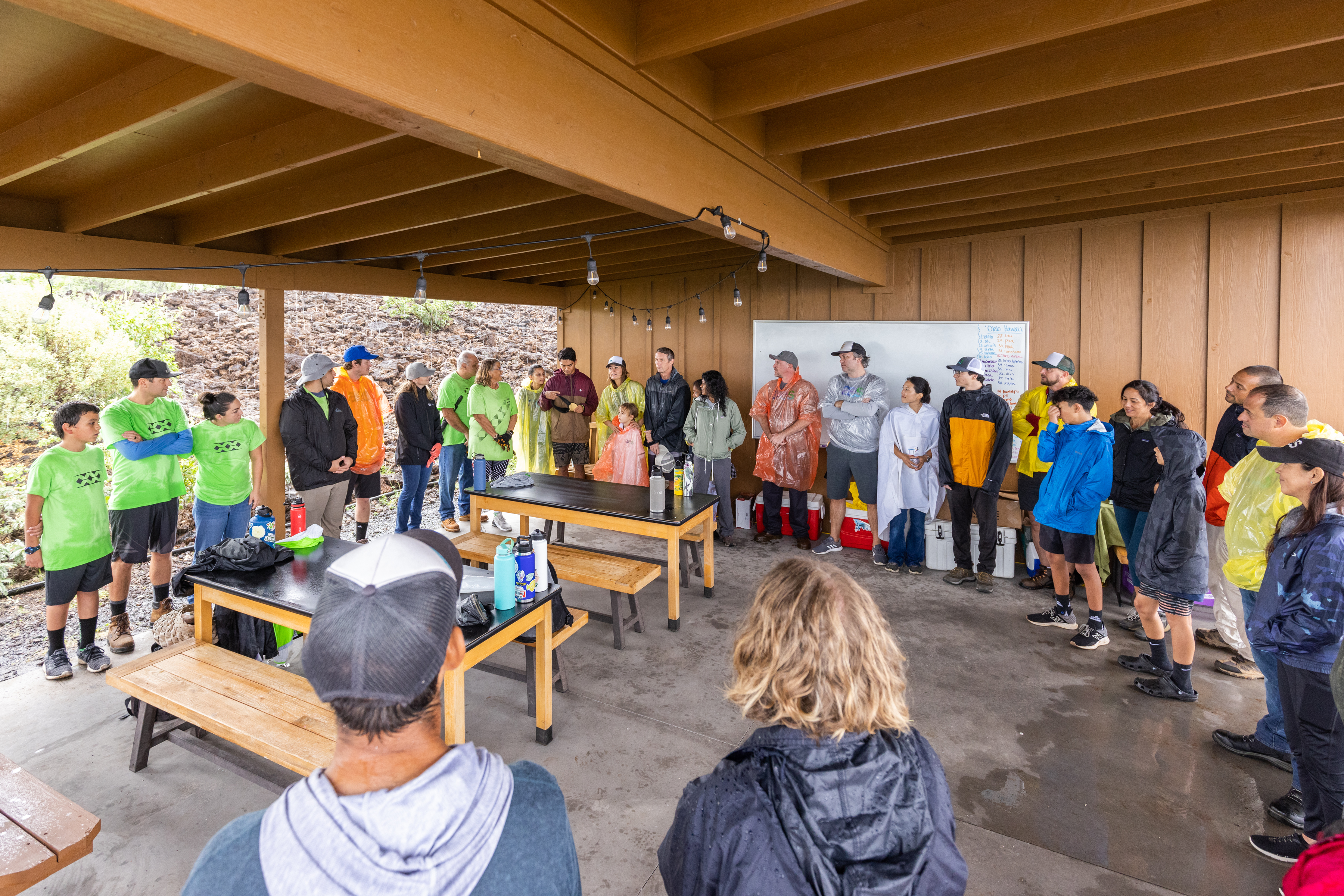
-
-
Comprehensive communications plan
-
A significant goal of AES Hawai'i's Community Outreach Plan is to inform stakeholders and neighboring communities about the Project and its progress and collect their feedback. AES Hawai'i will continue to build upon our previous experience to provide timely updates through a comprehensive community outreach schedule. AES Hawai'i is committed to sharing important information about the Project before any community meetings. Specific tactics used to share information and gather input will include, but are not limited to:
- Issuance of Public Community Meeting Notice(s)
- Conducting Public Community Meeting(s)
- Conducting strategic outreach to area organizations, community leaders, and elected officials
- Dedicated Project email address (keamukusolar@aes.com) to gather input, comments, and questions
- Dedicated Project phone number (+1 (808) 800-3942)
- Construction and status updates will be posted on the Project website (https://www.aes-hawaii.com/hawaii/project/keamuku-solar);
- Issuance of monthly project status updates to our Project mailing list; and
- Public Community Meeting Summary posted to the Project website.
Our community outreach efforts include informing stakeholders and neighboring communities of the Project, communicating potential environmental, social, economic, and land use changes, and answering questions.
AES Hawai'i plans for either in-person or virtual community meetings based on public health and safety conditions at the time. To support community awareness of meetings, AES Hawai'i will issue media advisories a minimum of 30 days before a public meeting to Hawaii Island and statewide media, including but not limited to, the Hawaii Tribune Herald, West Hawaii Today, Civil Beat, Hawaii News Now, KHON2 News, and KITV4 News. Additionally, we will advertise in area community publications and provide email notifications to stakeholders and those who have signed up for updates through the Project mailing list.
Public comments supporting and opposing the proposed Project are compiled and shared with Hawaiian Electric, to be filed with the Public Utilities Commission.
AES Hawai'i believes in the importance of maintaining community collaboration and consultation throughout the Project lifecycle and has successfully implemented this strategy with Hawaiian Electric Company's RFP Phase 1 & 2 projects. Throughout this process, collecting, considering, and responding to feedback from stakeholders and neighboring communities has enabled AES Hawai'i to garner support and tailor each project to address and mitigate community-identified issues or concerns.
One of the earliest steps we take when starting a new project is to engage area community leaders, elected officials, residents, key government and industry organizations, and businesses. This approach enables AES Hawai'i to share information about the Project, build support and develop mitigation measures for community-identified issues of concern.
Construction related updates
AES Hawai'i is committed to providing project status updates via email to our Project mailing list at least once per month and in conjunction with key milestones to ensure community members and stakeholders have the opportunity to provide feedback as required by the RFP.
-
Community benefits
-
Image
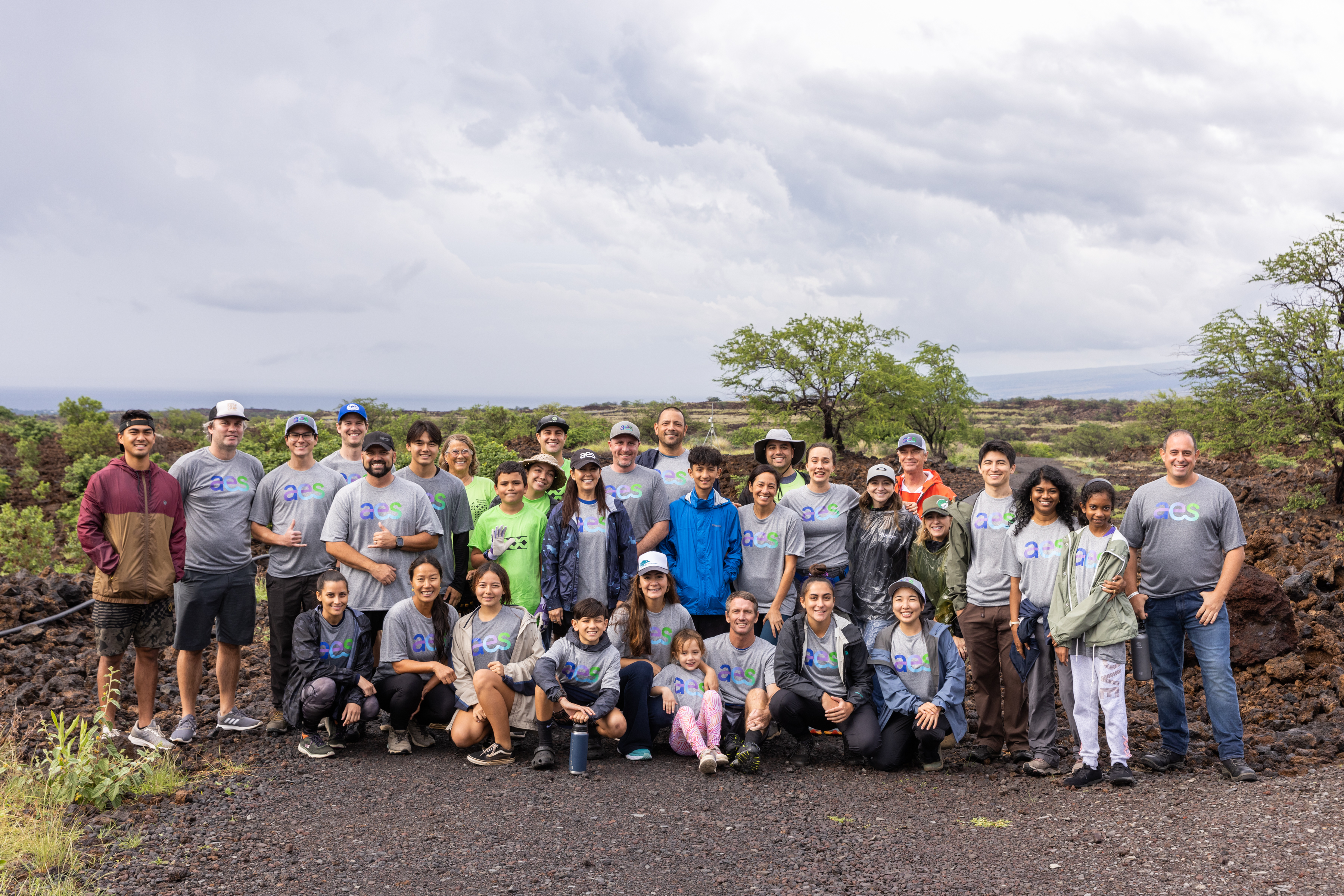
AES Hawaiʻi understands that each community in Hawaiʻi is unique, with different issues, priorities, and needs. As outreach continues, the Project Team will gather input and feedback to further refine the design, inform future engagement, and identify beneficiaries of the Community Benefits Program (CBP).
Our early stage outreach provided insight into the type of community benefits West Hawai‘i residents value most. During each meeting with the broader public and community leaders, the Project Team has explicitly requested feedback from participants on possible organizations, programs, and/or projects that should be considered as potential beneficiaries of the CBP.
As outreach continues, the Project Team will continue to consult and solicit feedback and guidance from the community on where these funds are needed the most. This feedback will form the basis of the CBP, ensuring it is specifically tailored to meet the needs identified by the host community.
To date, feedback from community members regarding potential beneficiaries of the CBP has included requests to support education, workforce development, and community health and well-being.
Community Benefits Program
The Seller, Keamuku Solar, LLC, is committed to providing a Community Benefits Program (CBP) of $3,000 per MW per year for the Project. As part of this commitment, the Project has identified the AES Hawaiʻi Foundation (AHF or the Foundation) as a potential non-profit entity for the distribution of CBP funds. The Foundation is a 501(c)(3) nonprofit organization founded in December 2021 and is dedicated to empowering local communities through partnerships with other nonprofits to create a brighter, more sustainable future.
The primary advantage of utilizing AHF is that the Foundation will separately pay for its administrative costs, enabling all CBP funds to directly benefit the community without overhead expenses or additional costs being deducted from them. The Foundation’s professional staff shall be responsible for disbursements to organizations, programs and projects supported by the community in relation to the Project, leveraging the focus and charitable giving experience of the Foundation. In addition, the policies, procedures, and reporting requirements of the Foundation will provide transparency under the PPA requirements.
The Project Team described this potential relationship with AHF during outreach meetings to gain feedback on the concept and underscore the Team’s commitment to ensuring community benefits are distributed efficiently and effectively to the host community. To date, the Project has not received any comments in opposition or objections to the proposal.
About the AES Hawaiʻi Foundation
The Foundation was established in December 2021 and was formed to serve as the central hub of AES Hawaiʻi’s social impact giving and to further the goal of unifying and amplifying AES Hawaiʻi’s longstanding commitment to community engagement. The Foundation is recognized by the IRS as a 501(c)(3) tax-exempt organization.
The mission of AHF is to empower our local communities through partnerships with nonprofits to create a brighter, more sustainable future.
Additional community benefits
Additional Project benefits and impacts were assessed by the commissioning of a preliminary economic and fiscal analysis. The analysis was based on preliminary project schedules and conceptual design and was conducted in constant 2023 dollars.
1. Project construction will result in economic output benefiting Hawai‘i's economy.
-
The Project is anticipated to create approximately 1,908 direct, indirect andinduced jobs.
-
The Project is anticipated to generate approximately $353 million indirect,indirect and induced economic activity.
2. Local Labor & Prevailing Wage
-
AES Hawaiʻi has a history of working with local labor organizations, including:
-
Hawaiʻi Carpenters Union
-
International Brotherhood of Electrical Workers, Local 1186
-
Hawaiʻi Laborers Union, Local 368
-
Hawaiʻi Operating Engineers, Local 3
-
-
AES Hawaiʻi is deeply committed to maintaining these partnerships and providing opportunities for local residents to work in the renewable energy industry.
- Construction will create direct, indirect and induced jobs that benefit the local labor market.
3. The Project is anticipated to reduce environmental impacts and increase energy resilience with local renewable power production.
-
Anticipated to generate approximately 20% of Hawaiʻi Island’s energy needs.*
-
Upon completion, the Project is estimated to power the equivalent of 35,336 homes with clean, renewable energy annually.*
-
The Project is expected to prevent the consumption of more than 8.4 million barrels of oil over its 25-year lifespan.*
4. The Project provides fixed, low-cost, reliable renewable energy pricing compared to the fluctuating cost of fossil fuels.
5. The Project helps to support the phasing out of traditional fossil fuel plants and grid modernization
6. The energy produced from this Project will help the state achieve its goal of 100% renewable energy generation by 2045 and offset Hawaiʻi’s reliance on price-volatile, imported fossil fuel.
As predevelopment of the Project proceeds, additional opportunities for benefits will be explored in direct collaboration with the area communities.
-
-
Community meetings and presentations
-
July 23, 2024 Waikoloa Village Association Meeting
Presentation: Keʻāmuku PPT- WVA meeting
August 13, 2024 Keamuku Solar + Storage Community Meeting
Meeting recording: Watch video here
Presentation: Keʻāmuku PPT Community Meeting
-
Community Outreach Plan
Environmental Permits and Approvals Strategy:
- Perform extensive due diligence on the site;
- Identify community organizations, area leaders and key stakeholders;
- Engage early and often with aforementioned individuals and organizations to share information and gather feedback; and
- Proactively consult with resource and permitting agencies.
Due diligence |
Status |
|---|---|
| Initial Community Assessment and Outreach |
Initial community outreach and sentiment survey completed; community engagement will continue throughout Project development |
| Permit Assessment |
The assessment of permits and the required land use approvals needed is complete |
| Title and Easement Review |
Title and easement review completed |
| Archaeological Resources |
Literature Review and Field Investigation (LRFI) completed. |
| Cultural Resources |
Preliminary assessment completed, Cultural Impact Assessment in process. |
| Biological Resources |
Desktop assessment completed; field survey to be conducted |
| Waters of the U.S. Delineation and Jurisdictional Determination |
To be conducted following selection by Hawaiian Electric Company |
| Phase I Environmental Site Assessment (ESA) |
Phase I ESA completed |
| Geotechnical and Soils Investigation |
Desktop geotechnical assessment (inclusive of site visits and consultation with local civil/geotechnical firms) completed; full geotechnical and soils investigation to be conducted following selection by Hawaiian Electric Company |
| Visual Resources |
Preliminary visual simulations and glint/glare study conducted. Updates to be conducted as design continues to be refined. |
| Traffic Impact Assessment |
A Traffic Impact Analysis Report (TIAR) has been completed. Multiple access points, a Construction Traffic Management Plan (TMP), and other best practices will be adopted based on the study. Upon completion of construction, the Project is only anticipated to require 4-5 vehicles per day to maintain operations over its lifespan. |
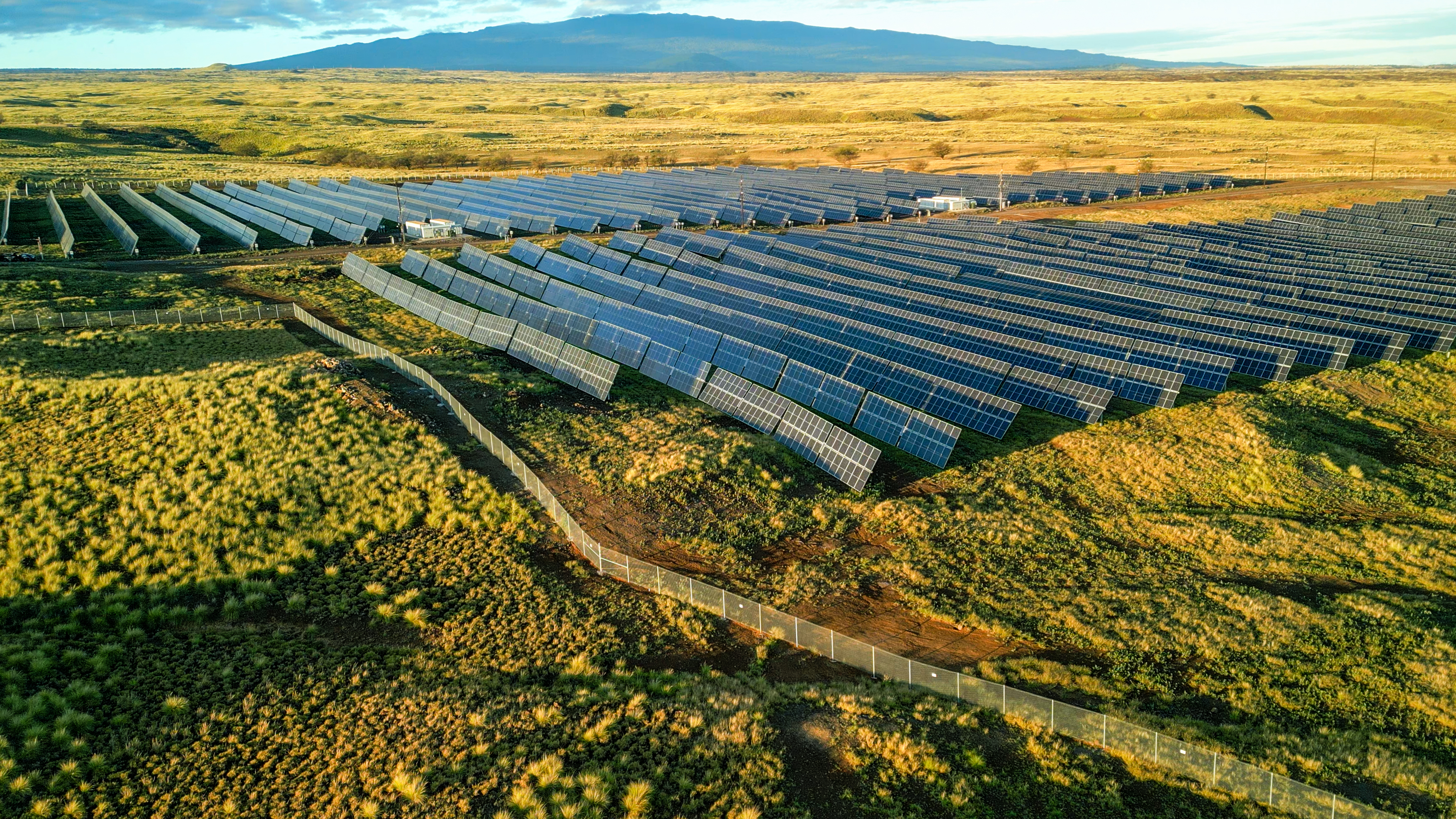
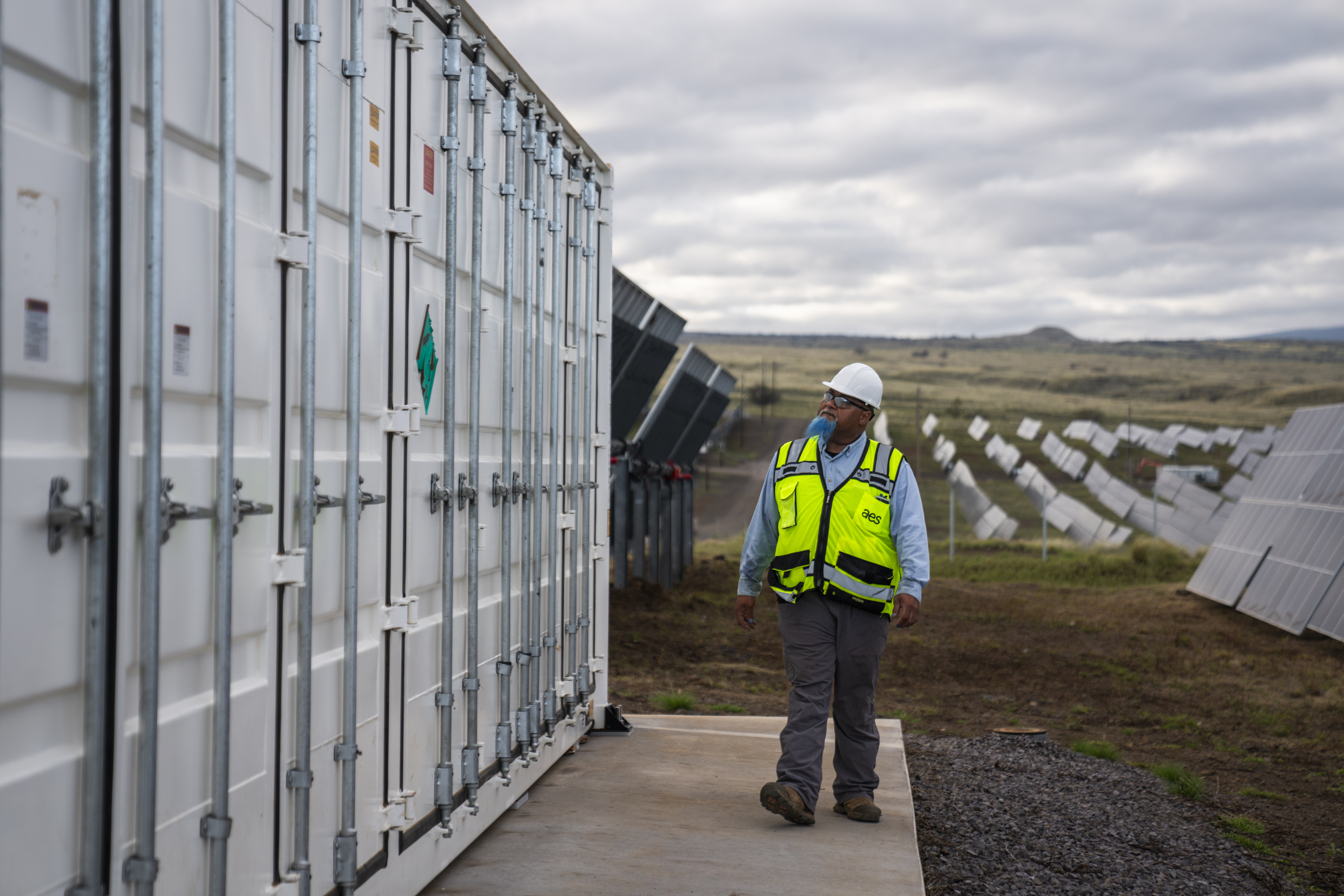
Based on these land use and zoning designations, the proposed solar and energy storage facility is a permissible use. No changes in the land use district or zoning classification are expected to be required for Project implementation.
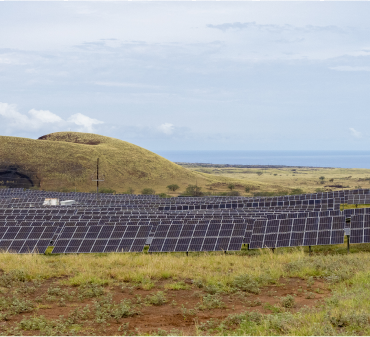
|
State Land Use District: |
Agriculture |
|
Land Study Bureau Soil Classification: |
Classes D and E |
|
HRS Chapter 205 Important Agricultural Land Designation: |
No IAL designation |
|
County of Hawaiʻi Zoning District: |
Agricultural (A‐20a; ~78 percent) and Open (O; ~22 percent) |
|
Special Management Area (SMA): |
Not located in the SMA |
Based on a preliminary review, the following determinations have been made:
U.S. Federal
- Federal permits or approvals are not anticipated for project implementation
- Compliance with the National Environmental Policy Act (NEPA) is not anticipated
Hawaiʻi County
- County Plan Approval
State of Hawaiʻi
- An Environmental Assessment (EA) or Environmental Impact Statement (EIS) are not anticipated – the Project does not “trigger” HRS Chapter 343
- Certain construction-related State permits may be required, including:
- National Pollutant Discharge Elimination System (NPDES) permit
- Noise Permit
- Compliance and coordination with the State Historic Preservation Division under HRS Chapter 6E is anticipated
Listing of anticipated Permits and Approvals
Anticipated Permit/Approval |
Authorizing Agency |
|
County Plan Approval |
County of Hawaiʻi Planning Department |
|
HRS Chapter 6E Compliance (Historic Preservation Review) |
State Historic Preservation Division (SHPD) |
|
Grant of Access |
State of Hawaiʻi Department of Transportation (HDOT) Right‐of‐Way Branch |
|
National Pollutant Discharge Elimination System (NPDES) Permit |
State of Hawaiʻi Department of Health (DOH), Clean Water Branch |
|
Noise Permit |
DOH, Indoor and Radiological Health Branch |
|
Building and Electrical Permits |
County of Hawaiʻi Department of Public Works |
|
Grading, Grubbing, and Stockpiling Permits |
County of Hawaiʻi Department of Public Works |
|
Permit to Perform Work on State Highways |
HDOT District Office |
|
Permit for Work Within County Right‐of‐Way |
County of Hawaiʻi Department of Public Works |
|
FAA Filing of Notice |
Federal Aviation Administration (FAA) |
AES Hawai'i and its environmental consultant conducted a preliminary assessment of the environmental conditions at the site based on a review of publicly available maps, studies and previous environmental reports prepared for the property. More detailed information is being obtained through the due diligence and site-specific studies, as well as community feedback, and will be used to inform the design process.
The Project design will seek to avoid and minimize environmental impacts to the extent possible. Best Management Practices (BMPs) will be implemented to further minimize impacts throughout the Project lifecycle.
Feedback will be collected throughout the Project lifecycle, and updates will be provided as outlined in the Community Outreach section. To get the latest project information sign up to be placed on our mailing list.
-
Natural environment
-
Air Quality:
None of the equipment associated with the solar arrays or battery storage system emit air pollutants of any kind. Overall, the Project would provide a net benefit by replacing energy generated by burning fossil fuels with renewable energy, thereby reducing emissions of greenhouse gases.Biology:
A site‐specific biological survey would be conducted as part of the detailed due diligence effort and the results would be incorporated into the planning and design process; if any sensitive biological resources are identified during this survey, the appropriate steps will be taken to avoid, minimize and mitigate potential impacts.Natural Habitats and Ecosystems, Vegetation and Wildlife:
Based on available information, the Project area has likely been disturbed by past land uses, such as cattle grazing, which has presumably reduced the number and abundance of native species. In addition, a relatively recent wildfire that burned the northeastern corner of the Project area (Hawaiʻi Wildfire Management Organization 2013) has likely further transformed the habitats and ecosystems in the Project vicinity.Data from a statewide habitat assessment by U.S. Geological Survey characterize the Project area as comprised of mixed native and non‐native habitat in the central and northeastern portions, with patches of bare to sparsely vegetated areas in the western portion. It is likely that most of the Project area is dominated by non‐native species, particularly fountain grass (Cenchrus setaceus) and buffelgrass (Cenchrus ciliaris).
Wildlife expected to occur within the Project area include nonnative species that are typically found in disturbed areas on Hawaiʻi Island. Two previous biological surveys conducted in the Project vicinity recorded only non‐native birds, mammals, and insects. No critical habitat for wildlife species has been designated within or adjacent to the Project area.
Available data indicate the Project area does not contain any perennial streams or wetlands (USFWS 2022a). However, several non‐perennial (likely ephemeral) streams are identified in the Project area including two branches of ʻAuwaiakeakua Gulch and two branches of Popo‘o Gulch. The location of these features would be verified through a field assessment and the jurisdictional status would be verified with the U.S. Army Corps of Engineers (USACE).
In addition to the habitat types described above, it is important to note that the Project area is located on a geological substrate (pāhoehoe lava flows) where caves and lava tubes may be present. Should any caves or lava tubes be identified within the Project area, these would be investigated as part of the due diligence process and avoided as appropriate.
The Project is being designed to minimize ground disturbance and maintain ample, natural open space surrounding the Project facilities. Impacts to natural resources, including listed species that could possibly occur within or traverse over the Project area, will be avoided and minimized to the extent possible through implementation of standard measures.
Climate:
The Project would generate clean renewable energy which would replace the burning of fossil fuels for the production of electricity, thus offsetting greenhouse gas emissions and providing a beneficial impact on climate conditions.Soils:
Ground disturbance during construction would be primarily related to driving steel posts to support the racking system for the solar panels, trenching for placement of electrical wiring, and excavation for foundations for the battery storage units, substation and interconnection facilities. All equipment will be removed, and the site restored after the life of the Project leaving the soils in the same condition prior to construction.Topography and Geology:
Topographic surveys have been conducted to inform project design as well as to minimize ground disturbance to the greatest extent practicable. Project design will continue to be refined as additional site studies are conducted. -
Land regulation
-
Land Uses:
There will be no long-term impacts to future uses for this land.After the life of the PV + BESS facility the land will be restored for future uses.
Flood and Tsunami Hazards:
The Project has been sited to ensure Project infrastructure is outside the Hawai‘i Tsunami Evacuation Zone, and the Hawai‘i Department of Land and Natural Resources flood map’s flood zones A, AE, AEF, AH, AO, VE based on the Federal Emergency Management Agency’s Digital Flood Insurance Rate Maps.Noise:
The Project is not anticipated to generate meaningful noise impacts when operational. However, AES still plans to perform a noise assessment and, if required, obtain a noise permit for work during construction.Roadways and Traffic:
A Traffic Impact Analysis Report (TIAR) has been prepared and any required mitigation will be implemented during the construction phase of the Project. Once operational and for the duration of the project, it is anticipated there will be minimal new traffic generation.Utilities:
This project will not require any utilities during construction.
-
Socio-economic characteristics
-
The site is currently vacant land with similar uses surrounding the Project site. AES Hawai'i utilized the State of Hawai‘i Department of Business, Economic Development & Tourism (DBEDT) Map of Electricity Burdens on Hawai'i Households by Census Tract to preliminarily assess the Project’s location and distance from nearby residents and the energy burden (defined as percentage of gross household income spent on energy costs) of those closest communities. The site is located approximately 4.0 miles away from the nearest community with an average electricity burden of 3.89%.
According to the American Council for an Energy-Efficient Economy (ACEEE), the Median energy burden nationally is 3.1% and the median low-income energy burden is 8.1%, which puts this area at slightly above the national average for non-low-income households. According to the same source, a high energy burden is considered to be above 6% and a severe energy burden above 10%.
-
Aesthetic/visual resources
-
A visual impact analysis has been conducted and the Project will be designed to minimize visual impacts to the extent practicable.
-
Solid waste
-
The facility is not anticipated to generate solid waste.
-
Hazardous materials
-
A Phase 1 Environmental Assessment was conducted for the site and it was confirmed that no recognized environmental conditions (RECs), historical RECs (HRECs), or controlled RECs (CRECs) in connection with the subject property.
-
Water quality
-
A Waters of the U.S. Delineation and Jurisdictional Determination will be conducted prior to construction and any potential jurisdictional water feature is expected to be avoided such that the Project would not result in discharge to Waters of the U.S.
-
Public safety services (Police, Fire, Emergency Medical Services)
-
The Project is located near dense population centers and has access to Public Safety Services.
-
Recreation
-
The Project site does not host any recreation activities and will not impact future recreation activities.
-
Potential cumulative and secondary impacts
-
The Project would directly contribute to the state’s renewable energy goals and in doing so would directly contribute to replacing a portion of electricity that is currently generated by burning fossil fuels, thus reducing greenhouse gas emissions and other forms of pollution that are detrimental to the environment and human health.
AES Hawai'i is deeply committed to engaging with the community early and often throughout the Project’s lifespan.
AES Hawai'i takes the Archaeological and Cultural Resources review very seriously. As we have done for all Hawai‘i projects previously developed or currently in development, this project will undergo extensive Archaeological and Cultural reviews to gain a comprehensive understanding of the land and any potential impacts resulting from the proposed development. To the extent practicable, all steps will be taken to carefully record, avoid, and/or mitigate impacts to archeological and cultural resources. Past practices that may be utilized for this project include, but are not limited to: hiring local on-island firms to perform an Archaeological Inventory Survey Report (AIS), Ka Pa'akai Analysis, Cultural Literature Review, Archeological Literature Review and Field Inspection Report and Cultural Impact Assessment (CIA). These initiatives will often include interviews and consultation with lineal and cultural descendants, kupuna, Native Hawaiian Organizations (NHOs), agencies and area cultural leaders, and presentations to interested groups and parties.
AES Hawai'i has engaged a local archeological firm and cultural consultancy to conduct early-stage initial analysis that identifies:
- valued cultural, historical, or natural resources in the area in question, including the extent to which traditional and customary native Hawaiian rights are exercised in the area;
- the extent to which those resources – including traditional and customary native Hawaiian rights – will be affected or impaired by the proposed action; and
- the feasible action, if any, to be taken to reasonably protect any identified cultural, historical, or natural resources in the area in question, and the reasonable protection of traditional and customary native Hawaiian rights in the affected area.
AES Hawai'i has also engaged the firm to perform an Archaeological Literature Review and Field Inspection Report (LRFI) for the proposed Project Area.
In addition, the firm will conduct a preliminary cultural review and Cultural Literature Review (CLR) to understand and anticipate potential cultural resource impacts.
LRFI Findings Summary
The LRFI investigation was conducted – through historical, cultural, and archaeological background research and field inspection of the Project area. An Archeological Inventory Survey (AIS) is in process.
Ka Pa'akai Analysis
AES Hawai'i is committed to conducting a Ka Pa'akai Analysis. In addition, AES Hawai'i will consult with SHPD to determine whether a CIA is warranted based on the results of the CLR and Ka Pa'akai Analysis.
*Subject to change based on further analysis

